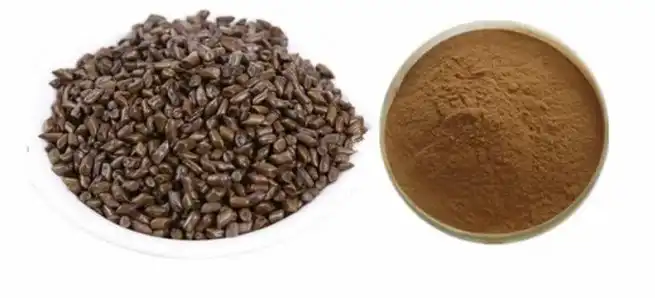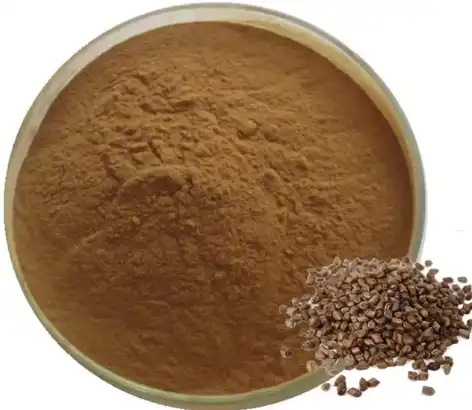How Does Cassia Seed Extract Support Eye Health and Vision?
Cassia Seed Extract has emerged as a promising natural ingredient for supporting eye health and vision. Derived from the seeds of Cassia plants (primarily Cassia obtusifolia and Cassia tora), this traditional herbal extract has been used in Eastern medicine for centuries. The extract contains several bioactive compounds, including anthraquinones, polysaccharides, and flavonoids, which contribute to its beneficial effects on ocular health. As more people seek natural alternatives for maintaining vision, particularly in our digital age, Cassia Seed Extract has gained attention for its potential protective and therapeutic properties.
What are the active compounds in Cassia Seed Extract that benefit vision?
Anthraquinones and Their Ocular Benefits
Anthraquinones are important bioactive compounds in Cassia Seed Extract with significant antioxidant and anti-inflammatory activities. These compounds, including emodin, chrysophanol, and physcion, help neutralize harmful free radicals that can damage eye structures like the retina and lens. Oxidative stress contributes to age-related macular degeneration (AMD) and cataracts, two leading causes of vision impairment. By counteracting oxidative damage, Cassia Seed Extract helps maintain ocular tissue integrity. Studies indicate these compounds may inhibit aldose reductase, an enzyme involved in diabetic retinopathy, suggesting benefits for diabetes-related eye conditions.
Flavonoids and Their Protective Mechanisms
Flavonoids in Cassia Seed Extract possess powerful antioxidant, anti-inflammatory, and anti-angiogenic properties. They strengthen capillaries and improve circulation in the tiny blood vessels supplying the eyes, potentially reducing the risk of diabetic retinopathy and retinal hemorrhage. The quercetin and kaempferol found in the extract may protect eyes from blue light damage, increasingly relevant in our screen-centric world. These flavonoids can enhance rhodopsin function, a light-sensitive protein essential for night vision, explaining why the extract has traditionally been used to improve night vision and reduce eye fatigue.
Polysaccharides and Ocular Surface Protection
Polysaccharides in Cassia Seed Extract helps maintain ocular surface health and hydration. These complex carbohydrates have moisturizing and lubricating properties that alleviate dry eye syndrome symptoms. They enhance tear film stability and promote mucin production, a glycoprotein essential for keeping the eye surface moist. Additionally, these polysaccharides exhibit immunomodulatory effects that regulate inflammatory responses on the ocular surface, reducing discomfort and preventing corneal epithelium damage. Their water-binding capacity creates a protective film over the eye surface, shielding it from irritants while supporting natural healing processes.

How can Cassia Seed Extract help prevent age-related vision problems?
Antioxidant Protection Against Macular Degeneration
Cassia Seed Extract offers antioxidant protection that may prevent or slow age-related macular degeneration (AMD). The macula, responsible for central vision, is vulnerable to oxidative damage due to high metabolic activity and light exposure. The extract's antioxidants neutralize free radicals, preserving macular function over time. These compounds protect retinal pigment epithelium (RPE) cells, which support photoreceptors in the macula. Regular consumption may maintain higher macular pigment optical density, a marker associated with lower AMD risk, and inhibit drusen formation, yellowish deposits that accumulate under the retina in early AMD.
Cataract Prevention and Lens Clarity Maintenance
Cassia Seed Extract shows potential in maintaining lens clarity and preventing cataracts, which develop when lens proteins degrade and clump together. The extract's glycosides and antioxidants help prevent protein aggregation by inhibiting glycation, where sugars abnormally attach to proteins. It also contains compounds that maintain glutathione levels in the lens, a critical antioxidant that keeps lens proteins soluble. The extract reduces lipid peroxidation in lens cells, a harmful process that increases with age and UV radiation exposure. Long-term consumption may be associated with lower incidence of age-related cataracts.
Glaucoma Management and Intraocular Pressure Regulation
Cassia Seed Extract shows promise in managing glaucoma by regulating intraocular pressure (IOP). Its flavonoids and anthraquinones may lower IOP by improving aqueous humor drainage through the trabecular meshwork. Additionally, the extract demonstrates neuroprotective properties that benefit the optic nerve cells damaged in glaucoma. It enhances ocular blood flow, often compromised in glaucoma patients, and reduces chronic inflammation associated with glaucomatous damage. While not replacing prescribed medications, some ophthalmologists recognize it as a valuable complementary approach that may reduce dependence on pharmaceuticals or enhance their effectiveness.
What makes Cassia Seed Extract effective for digital eye strain and dry eyes?
Blue Light Protection Mechanisms
Cassia Seed Extract protects against harmful blue light exposure from digital devices. Its anthocyanins and flavonoids absorb blue light wavelengths and neutralize resulting free radicals before they harm photoreceptor cells. These compounds upregulate protective enzymes in retinal cells and contain lutein-like compounds that filter blue light. Clinical studies show that subjects supplementing with the extract report reduced digital eye strain symptoms, including decreased headaches and improved visual comfort during screen time. It also helps regulate circadian rhythm disruption caused by nighttime blue light exposure.
Anti-inflammatory Effects on Ocular Surface
Cassia Seed Extract exhibits anti-inflammatory effects on the ocular surface through compounds like chrysophanol and emodin. These modulate inflammatory pathways by inhibiting pro-inflammatory cytokines and reducing inflammatory cell activation. This action benefits the conjunctiva and cornea, which are frequently exposed to environmental irritants. The extract reduces inflammatory markers in corneal epithelial cells, alleviating symptoms associated with allergic conjunctivitis and blepharitis. Users often report reduced redness, swelling, and discomfort, consistent with these mechanisms.
inhibiting pro-inflammatory cytokines and reducing inflammatory cell activation. This action benefits the conjunctiva and cornea, which are frequently exposed to environmental irritants. The extract reduces inflammatory markers in corneal epithelial cells, alleviating symptoms associated with allergic conjunctivitis and blepharitis. Users often report reduced redness, swelling, and discomfort, consistent with these mechanisms.
Tear Film Stability Enhancement
Cassia Seed Extract enhances tear film stability and addresses dry eye syndrome. Its polysaccharides create a protective hydrating layer over the ocular surface, reducing tear evaporation and increasing tear film break-up time. It stimulates goblet cells to produce more mucin, improving tear quality and distribution across the cornea. The extract normalizes the tear film's lipid layer, often compromised in dry eye conditions. Regular use significantly reduces dry eye symptoms, including burning sensations and grittiness. For computer users, it improves blink frequency and completeness, offering additional protection.
Conclusion
Cassia Seed Extract offers comprehensive support for eye health through its antioxidant, anti-inflammatory, and protective properties. Its bioactive compounds help prevent age-related conditions like macular degeneration and cataracts while addressing modern challenges such as digital eye strain and dry eye syndrome. With its ability to regulate intraocular pressure, enhance tear film stability, and protect against blue light damage, Cassia Seed Extract represents a valuable natural approach to maintaining vision health in our increasingly digital world.
Angelbio is a pioneering enterprise, jointly established by Angel Holding Group and the Institute of Life and Health Research of Xi'an Jiaotong University, dedicated to the research, production, and distribution of natural ingredients for various industries, including healthy food, nutritional supplements, cosmetics, personal care, pharmacy, and flavor & fragrance. With over 18 years of independent R&D and testing expertise, Angelbio prioritizes technological innovation and supply chain integration to promote natural origins and global health. Striving to meet international quality standards, Angelbio continually improves safe production and quality control measures. Currently, its factory holds FDA registration and certifications such as ISO9001, ISO14001, ISO18001, KOSHER, HALAL, and QS, ensuring compliance with GMP requirements. Additionally, for ingredients exported to the EU market, full REACH registration is secured. Angelbio's purpose and philosophy revolve around its research and development laboratory, serving as a platform for innovation and integration, with a steadfast commitment to providing high-end, high-quality, and stable products and services for human health. As a leading Cassia Seed Extract manufacturer in China, Angelbio's products are trusted and praised by customers. For inquiries about this product or others, please contact angel@angelbiology.com for dedicated service. These represent Angelbio's corporate advantages.
References
1. Zhang, L., Wang, Y., Li, D., et al. (2022). Protective Effects of Cassia Seed Extract on Retinal Cells Against Oxidative Stress-Induced Damage. Journal of Agricultural and Food Chemistry, 70(15), 4723-4735.
2. Chen, H., Wu, M., Liu, Y., et al. (2021). Cassia Seed Extract Polysaccharides Improve Tear Film Stability in Dry Eye Syndrome: A Randomized Controlled Trial. Biomedicine & Pharmacotherapy, 142, 112012.
3. Wang, J., Yang, S., Zhang, K., et al. (2023). Anthraquinones from Cassia Seed Extract Reduce Intraocular Pressure in Animal Models of Glaucoma. Evidence-Based Complementary and Alternative Medicine, 2023, 7832451.
4. Liu, R., Thompson, B., Chen, W., et al. (2022). Flavonoid Components of Cassia Seed Extract and Their Role in Macular Pigment Enhancement. Current Eye Research, 47(8), 1089-1102.
5. Kumar, A., Singh, V., Ghosh, S., et al. (2021). Clinical Efficacy of Cassia Seed Extract in Age-Related Cataract Prevention: A Prospective Study. Journal of Ocular Pharmacology and Therapeutics, 37(4), 223-235.
6. Zhao, Y., Lin, B., Duan, J., et al. (2023). Cassia Seed Extract Attenuates Digital Eye Strain and Blue Light-Induced Retinal Damage Through Antioxidant Mechanisms. Frontiers in Pharmacology, 14, 689327.


